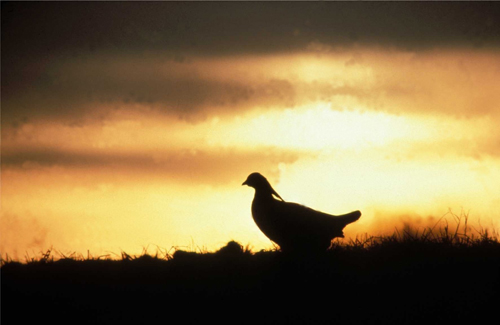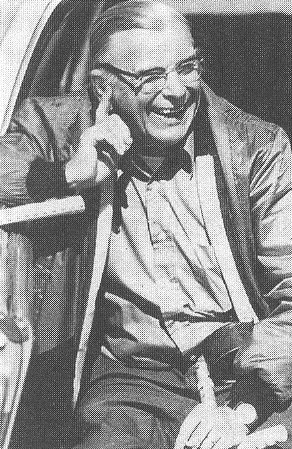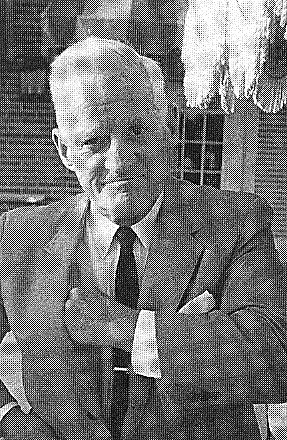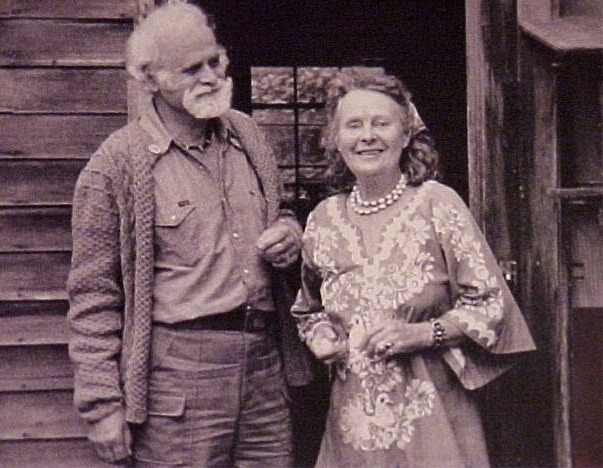Wisconsin's Prairie Chickens
People
The comeback story of the greater prairie chicken in Wisconsin was
written by many people--individuals who were passionate about protecting a small
piece of our natural heritage partnered with wildlife managers and researchers
who could see how it might be done. Their unique partnership began as a suitable
blend of all the necessary components. It stands as one of the most successful
private/public collaborative efforts ever organized in the name of
conservation. This joint effort continues today to support the grassland
management program in central Wisconsin.
 The story begins with pioneering research by the husband and
wife team of WDNR wildlife biologists, Fred and Frances Hamerstrom. Their
outdoor laboratory was the drained marshland in southwestern Portage county,
locally referred to as Buena Vista Grassland. The Hamerstroms' work culminated
in 1957 with an urgent call for habitat protection for the prairie chicken, or
certain extirpation in Wisconsin would occur in a few short years. The birds
had not been hunted in the state since 1955, but a loss of suitable grasslands
to intensive agricultural development was continuing at a rapid rate.
The story begins with pioneering research by the husband and
wife team of WDNR wildlife biologists, Fred and Frances Hamerstrom. Their
outdoor laboratory was the drained marshland in southwestern Portage county,
locally referred to as Buena Vista Grassland. The Hamerstroms' work culminated
in 1957 with an urgent call for habitat protection for the prairie chicken, or
certain extirpation in Wisconsin would occur in a few short years. The birds
had not been hunted in the state since 1955, but a loss of suitable grasslands
to intensive agricultural development was continuing at a rapid rate.
The Hamerstroms' message, alone with growing interest among private
conservation groups, already had prompted Wisconsin Conservation Department
(forerunner of the WDNR) to issue a policy statement declaring the state's
commitment to saving a dwindling prairie chicken population.
Things began rolling when one of the most
active private conservation groups in the state, the Dane County  Conservation
League (DCCL), took notice of the prairie chicken dilemma in 1958 and recognized
that protection of the habitat in central Wisconsin was critical for
survival of the species. The DCCL's Paul Olson solicited private donations to
purchase land and arrangements were made to lease that land to the DNR. At
last, state wildlife experts could begin a serious habitat management
program.
Conservation
League (DCCL), took notice of the prairie chicken dilemma in 1958 and recognized
that protection of the habitat in central Wisconsin was critical for
survival of the species. The DCCL's Paul Olson solicited private donations to
purchase land and arrangements were made to lease that land to the DNR. At
last, state wildlife experts could begin a serious habitat management
program.
Increased visibility of the chickens' plight led, in 1961, to
formation of the Society of Tympanuchus Cupido Pinnatus, Ltd., an organization
founded solely for the purpose of protecting and preserving Wisconsin's prairie
chickens. Much like the DCCL awakening, the Society grew from the experience of
a group of concerned conservationists - this time from Milwaukee - who visited
the booming grounds one April. There they witnessed the bird that is its own
best salesman. The Society soon began a broad-based fundraising program that
made possible the purchase of additional large tracts of land in the central
Wisconsin area, which also were earmarked for DNR management. Today, over
15,000 acres have been acquired for prairie chicken management thanks in large
part to the combined efforts of these two organizations.
Paul Olson
 R
Recalling his
impression of seeing male prairie chickens performing their booming ritual, Paul
Olson said it left him "bug-eyed" and determined to go to work. That was 1958
and, as founding father of the Dane County Conservation League, Olson had worked
for years with other private citizens on the conservation front. Olson saw the
prairie chickens as a chance to guarantee the continued existence of a native
bird on the Wisconsin Landscape. The DCCL, with Olson in the lead, generated
public interest and private funds to purchase land in central Wisconsin and
launch a protection program that is the envy of like-minded conservationists
across the country. For more than 25 years, Olson helped weave the pieces
together - the Hamerstroms' research, DNR project managers, members of the
Tympanuchus Society, lawyers who worked gratis, legislators, and donors who
cared. Paul Olson explained his devotion to the saving of Wisconsin's Prairie
Chickens as a natural desire to leave a legacy for his children. In fact, we
all inherit the results of his commitment. In his own words, "It worked!"
 Willis Sullivan
Willis Sullivan
Willis Sullivan, too, can be credited with writing an
important chapter in the effort to purchase and protect land for prairie chicken
habitat in Wisconsin. A chance meeting with Dory Vallier, a friend and fellow
conservationist who was active in early efforts to save the grassland habitat,
stirred Sullivan's own interest in the plight of the precious bird. In April of
1961, Sullivan made his first visit to view a spring booming, and he was
hooked. "It was like learning a long-forgotten friend was in trouble," he
recalled. Sullivan moved quickly to organize a group of committed people into
what became the Society of Tympanuchus Cupido Pinnatus, Ltd. Behind this
tongue-twisting, affectionate name was a fundraising powerhouse. Sullivan and
the Society spread the net wide, including individuals and institutions
worldwide who were all interested in the preservation of a species that , once
seen, could not be ignored. For Willis Sullivan it was "the accomplishment of
my life." For the greater prairie chicken of Wisconsin, support from the
society continues to provide the lifeblood necessary for survival.
Fred and Fran Hamerstrom
 P
Prairie chicken
research in Wisconsin was the heart and soul of scientific study for Fredrick
and Frances Hamerstrom. For more than 40 years, they worked side-by-side,
acquiring an intimate knowledge of the birds that still remained in the central
part of the state. Habitat loss had pushed the greater prairie chicken from the
savannas and prairie wilderness of southern Wisconsin. It was the landmark work
of the Hamerstrom's that, by the mid-1950's, signaled an absolute urgency for
establishing a management program in the remaining grasslands of Wisconsin, or
the species would be gone from the state forever. Wisconsin's greater prairie
chicken population exists today because their call for preservation was heard
and heeded in time. Husband and wife studied with the great Wisconsin
naturalist Aldo Leopold in the 1930s and 1940s and worked together fervently on
prairie chicken research for the DNR from 1948 to 1972. The Hamerstroms'
studies and observations prompted efforts by private groups to purchase land for
lease to the DNR to establish a grassland management program. The result is the
heroic habitat restoration effort that has saved the greater prairie chicken and
its grassland habitat in central Wisconsin.
Dory
Vallier and Gordon Kummer
Dory Vallier and Gordon Kummer, a husband
and wife team, were on their way to visit a property near Tomahawk, Wisconsin
that they were interested in purchasing. On the way they decided to visit their
friends the Hamerstroms. According to Dory, Fran was particularly persuasive in
describing their plan to protect prairie chicken habitat. The plan consisted of
purchasing blocks of land and restoring the habitat. The plan would create a
checkerboard effect at the Buena Vista Grassland which the Hamerstroms believed
would aid in the survival of the prairie chickens. At the time, land was being
cleared for vegetable production and remaining habitat was quickly
disappearing.
Gordon Decided to help by purchasing the
first 40 acres of prairie chicken refuge. The couple quickly became committed
and dedicated to the cause of saving the prairie chickens. They formed the
Society of Tympanuchus Cupido Pinnatus, Ltd. Dory continues to participate in
the group's annual meeting.
